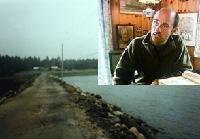Photo. Causeway to Oak Island included small image of Petter Amundsen, Norway. Image from the documentary on television.
The photo of the causeway to Oak Island was taken by Stein Morten Lund in Travel Explorations, who has followed the mystery since he was a child.
Amundsen claims to prove that William Shakespeare's works are not written by the author himself. Through hidden messages and codes, Amundsen reached the wonders hides a treasure map - a map that leads to a treasure on Oak Island at the coast of Nova Scotia, an island that has been in the spotlight for treasure hunter through hundreds of years. That is where he is heading.
After several years of struggle against the authorities and land owners, he has now put himself on a plane to Canada to start negotiations with the authorities to drain the pond out of water. History Channel will follow him in his struggles to reveal the mystery for once.
Oak Island is a 140-acre (57 ha) island in Lunenburg County on the south shore of Nova Scotia, Canada. The tree-covered island is one of about 360 small islands in Mahone Bay and rises to a maximum of 35 feet (11 m) above sea level. Located 200 metres from shore and connected to the mainland by a modern causeway, the island is privately owned, and advance permission is required for any visitation.
Amundsen can not reveal the details about why he travels to Canada right now. He suggests however a scenario where they are allowed to drain the pond at Oak Island. - There is no digging, but investigations. We have applied for a so-called "non evasive approach." It is not intervention. We are not alone with the treasure in hand, he said.
The documentary "Sweet Swan of Avon - The Shakespeare Treasure" was shown on Norwegian TV NRK in 2009 in 4 episodes. It was based on a book Organisten (The Organ Player) written by Petter Amundsen and Erlend Loe from Norway.
In the summer of 2002 the life of organist Petter Amundsen was turned upside down. In his search to learn more about cryptography, he stumbled upon a string of ciphers in Shakespeare's First Folio. He was shocked to find what appeared to be another author, and even more curiously he found a treasure map leading to an island in Nova Scotia, Canada.
In the film Petter meets cryptographers, historians and SHAKESPEARE specialists in fight for support. Petter's work is based on well known code systems, and every step is thoroughly documented.
- Am I right in what treasure is, a temple in the word's original meaning, an elevation in the ground pointing to a storage of temple treasures from the 1100s, then the hell may be loose. It can cause enormous political consequences. So it is important to hurry slowly, says Amundsen to the Norwegian national newspaper Dagbladet.
For more information about the project and contribution to funding: New Jelly. NewJelly is a website that funds your creativity. This site helps the funding of all kinds of creative projects - be it art, food, technology, film, music or design.
Read more about the mystery on Oak Island on our global travel guide Travel Explorations.
Stein Morten Lund, 4th August 2013
Treasure theories (source: Wikipedia):
- Pirate treasure
- Naval treasure
- Marie Antoinette's jewels
- Exotic treasure (see additional information below)
- Freemasonry
- Natural sinkhole theory
Exotic treausure theori:
Still others have speculated that the Oak Island pit was dug to hold treasure much more exotic than gold or silver. In his 1953 book, The Oak Island Enigma: A History and Inquiry Into the Origin of the Money Pit, Penn Leary believed that English philosopher Francis Bacon used the pit to hide documents proving him to be the author of William Shakespeare's plays. Author and researcher Mark Finnan elaborated upon this theory. The theory was also used in the Norwegian book Organisten (The Organ Player) by Erlend Loe and Petter Amundsen. It has also been asserted that the pit may have been dug by exiled Knights Templar and that it is the last resting place of the Holy Grail or even the holy Ark of the Covenant.











